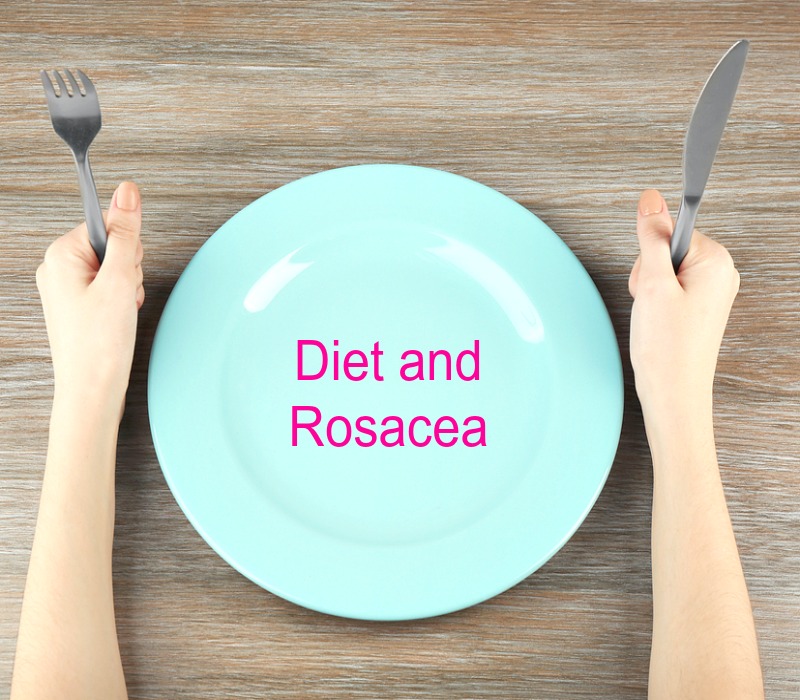- Home
- Troubled Skin
- Flushed Face
- Rosacea Prone Skin
I may earn from qualified Amazon & Affiliate purchases at no cost to you.
Rosacea Prone Skin? Eat This Not That
by: Linda Robison / Facial Fitness Specialist @ ABZ

Do you have rosacea prone skin? Well, put down that fork and read this first...
There is no cure for rosacea, however as per the study1, 73% of the patients suffering from rosacea altered their diet and supplements, and among them, 95% found the improvement in the symptoms caused by rosacea.
It clearly shows that foods and nutrients play a crucial role in controlling the severity of this skin inflammatory disease.
Rosacea prevention - What to eat now?
The gut-skin connection - Microflora reside in our gut and on our skin. These microorganisms release different chemical mediators and immune regulators that help to control inflammation.
If your diet doesn’t support a good gut microflora, it could worsen your rosacea symptoms.
H.pylori bacteria present in your gut is a harmful bacteria that is responsible for numerous digestive disorders as well as impacts the immune system of the body. If there is a presence of this bacteria in your gut, then also there is a chance to develop rosacea.
Consumption of prebiotics and probiotics helps in restoring your digestive health.
Prebiotic and Probiotic Foods
Prebiotics - Eating fruits and vegetables that are good sources of resistant starches and fibers provides excellent support to the good bacteria in your gut. These are known as prebiotics that support the probiotic bacterias.
Probiotics - Eating fermented foods such as kimchi, yogurt, kombucha and sauerkraut provides a good source of probiotics. These are good bacteria that fight off harmful bacteria in your gut to improve the digestive process. They help colonize the gut and maintain its microflora.
Probiotic bacteria need prebiotics to survive on your gut. Consuming diets rich in both of them will complete the cycle of maintaining your gut health.
The vitamin-rosacea connection - Certain nutrients, vitamins, and minerals have a favorable effect on the health of your skin and your rosacea symptoms.
Zinc - Food rich in zinc helps to maintain the alkalinity in your body. Foods that are a rich source of zinc are red meat, shellfish, legumes, seeds (squash, pumpkin, sesame), nuts, cheese, milk, eggs, etc.
Omega-3 fatty acids - These supplements also help the body to get into the alkaline state, reducing the acidity. Some examples of foods that contain omega-3 fatty acids are Mackerel, Salmon, Cod liver oil, Herring, Oysters, Sardines, Caviar, Flax seeds, Chia seeds, etc.
Apple cider vinegar - Consuming raw, unfiltered, mother apple cider vinegar consists of useful enzymes that kill the harmful bacteria, bringing your body back to an alkaline state.
When your body is in an acidic state, its functioning is affected. The detoxification and repair process of your body also gets hampered by it. Hence, there is a vital need to keep your body in an alkaline state.
Rosacea Flare-ups - What foods to avoid
Here is a basic list of the most common foods that can trigger rosacea flare-ups.
If you have rosacea prone skin, consider eliminating these foods (one by one) for 7-10 days and see if your rosacea symptoms improve.
Alcohol and rosacea - A sip of alcohol kicks off the flare in your skin. Some people slowly metabolize alcohol that poses a higher risk for them to develop rosacea.
Hot foods - Warm foods, hot liquids, and hot broths are likely to trigger the symptoms of this disease. Opt for lukewarm foods or foods that have fewer temperatures.
Capsaicin - It is present in spicy foods, chili, cayenne, and red peppers. If you have rosacea, then make sure you don’t consume such foods. Capsaicin precipitates the flare of your rosacea that worsens it.
Cinnamaldehyde - Cinnamaldehyde are vasodilators, which dilate the skin at a higher rate. When ingested, it can cause redness, blushing, increased sensitivity, and worsening rosacea. Some foods that contain cinnamaldehyde are cinnamon, nutmeg, tomatoes, dark chocolates, citrus fruits, grapefruits, etc.
It is present in many unrelated foods which makes it a challenge to identify its source. It is also present in skincare products and fragrance.
Rosacea prone skin and diet connection
So if you have rosacea-prone skin and exhibit symptoms such as flushing of the face, bumpiness, uneven skin texture, dullness, or dry patches on your cheeks, forehead, nose and chin, then consider changing your diet.
In addition to the cautions and diet supplements listed here, consider recording your day to day activities. This can help you to track your trigger sources. Tracing the cause of your trigger plays a crucial role in controlling rosacea.
Rosacea Prone Skin - FAQs
Q: Is there a specific rosacea diet I should follow?
A: While there isn't a specific diet for rosacea patients, there are certain foods that could be considered rosacea triggers and cause problems for people with this chronic skin condition. Foods such as hard liquor, red wine, hot beverages, hot sauce, hot spices, and even dairy products are known to be common triggers.
Q: I read that an alkaline diet can help rosacea sufferers, is that true?
A: Yes, eating low acidic, anti-inflammatory foods can help keep this inflammatory condition under control. Small dietary changes like eating more leafy greens, flaxseed oil, olive oil, fatty fish and fiber-rich foods can yield a significant improvement in facial redness, skin sensitivity, and other main symptoms of rosacea.
Q: Are they any vitamins I can take for rosacea treatment?
A: Nutritional supplements can help, but the best things you can do is to avoid trigger foods and make some minor lifestyle changes like wearing a sunscreen at all times and always use gentle skincare products specifically meant for sensitive skin.
Q: Can you give me an example of prebiotic foods I should eat?
A: Prebiotic foods are easy to work into your daily diet. They include: apples, bananas, legumes, beans, garlic, onions, asparagus, and oats.
Author Bio:
Henna is a wellness lifestyle writer. She loves sharing her thoughts and personal experiences related to natural remedies, yoga, and fitness through her writing.
References:
1. https://www.ncbi.nlm.nih.gov/pmc/articles/PMC5718124/
About the Author:
Linda Robison is a Facial Fitness Specialist and the founder of Anti-Aging Beauty Zone. She shares expert insights on skincare, facial rejuvenation, and beauty treatments—blending traditional wisdom, personal experience, and science-backed research for both at-home and in-office solutions.
Before you go ....
Please tap on the💙in the bottom right corner if you found this page helpful. Also, Let’s CONNECT! Click the buttons below to follow me on social media.
Thanks so much!

